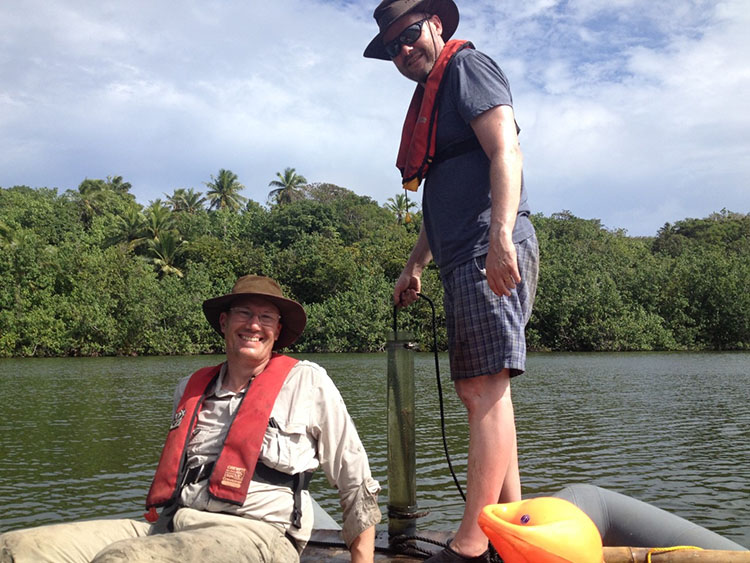Climate change encouraged discovery of Southern Cooks earlier than first thought
Tuesday 27 July 2021 | Written by Supplied | Published in Environment, National

Professor David Sear (left) and Professor Pete Langdon (right) taking core samples from Lake Te Roto in 2016. Supplied/ 21070938
A new study on Atiu has found evidence of exploratory voyages to the Southern Cook Islands up to three hundred years earlier than previously thought and well before first settlement. The research has been published in the Proceedings of the National Academy of Sciences of the USA and is summarised here for Cook Islands News by lead scientist, Professor David Sear.
In 2014 and 2016, a team of scientists from the University of Southampton, UK worked with Atiuans to collect sediment core sampling from Lake Te Roto, Atiu. The research was designed to help establish the date of first human arrival on the island, and to reconstruct the climate at the time of first settlement.
Our study found evidence of human dispersal into eastern Polynesia from islands to the west from around AD 900 – around 2-300 years earlier than existing archaeological evidence suggests.
On our last visit, lake sediment cores were taken from Lake Te Roto, Atiu, comprising more than 6500 years of near-continuous sediment accumulation.
These sediments suggest three sequential phases of environmental disturbance on Atiu -
• the arrival of exotic mammals (humans and/or pigs) (phase 1: c. AD 900);
• changes in the lake’s productivity and organic carbon sources roughly a century later (phase 2: c. AD 1000); and
• major catchment disturbances within the following century resulting from forest clearance (phase 3: c. post AD 1100).
These phases resonate with models of island settlement, that distinguish between island discovery, settlement, and establishment. New islands may be located during strategic exploratory voyages or as accidental landfalls, and in turn become localities of resource extraction (e.g., birds, marine resources) and/or waystations from which to conduct further exploration.
Given the distances between settled islands in the west and those of the vast East Polynesian region, provisioning stations (especially those with fresh water) may have been crucial in the eastward expansion process.
The Lake Te Roto, Atiu record suggests populations from West Polynesia began exploratory probes along the margins of East Polynesia into the Southern Cook Islands and possibly other nearby archipelagos such as the Society Islands, well before full-fledged colonizing expeditions were launched.
More modest changes in lake productivity followed in the next 1 to 2 centuries, potentially signalling the arrival of colonizing parties. Archaeologically, 11th-century colonists are suggested on the neighboring island of Mangaia, where Polynesian rats (Rattus exulans) and coral tools have been dated to this period.
By the 12th to 13th centuries, major lake catchment disturbances on Atiu are indicated, including vegetation burning and soil erosion. Both suggest forest clearance and probably agricultural activities—processes that are consistent with established, permanent, and larger settlements. These activities are archaeologically well-demonstrated on islands to the north (Aitutaki) and south (Mangaia) of Atiu indicating human populations had dispersed across the Southern Cook Islands by this time.
The Lake Te Roto findings also resonate with reconstructions of wind patterns and Polynesian voyaging to the region’s margins (Rapa Nui, New Zealand). Goodwin and colleagues identify key sailing windows, when “the centennial mean climate pattern resembles a shift to the Central Pacific (Modoki) El Niño pattern, with … anomalous westerly wind fields (trade wind reversals) over the Central Pacific.”
Relevant to the Te Roto findings, these researchers identify sailing windows between West Polynesia and the Southern Cook Islands around AD 860 to 900, when mammalian (pig/human) feacal sterols make their initial appearance in the Te Roto lake sediments.
Exploration voyages of the kind suggested here may have been planned to take advantage of such seasonal and inter-annual wind shifts, as these would have facilitated easy and safe homeward passages. A second key sailing window is identified at c. AD 1040 to 1060, coinciding with increases in Te Roto lake productivity and phase 3 colonisation.
We also undertook sediment core sampling in Samoa and Vanuatu to the west. The lake sediment archives from these sites, in combination with other published records, allow the reconstruction of past climate over the last 2 millennia and provide context for the trends observed at Lake Te Roto.
Our research indicates that the timing of human migration into East Polynesia coincided with a prolonged regional drought from AD 1000 to 1150 in the likely source region for early Cook Islands colonists. We believe this prolonged drought, stressing critical food and water resources, was a significant contributory factor in eastward exploration and subsequent colonization of the Southern Cook Islands and beyond. This long dry period coincided with the increased disturbance indicators on Atiu
The return of wetter conditions in East Polynesia after c. AD 1150 supported subsequent colonisation of other central islands and, eventually, migration into far eastern and South Polynesia.
As co-author Melinda Allen points out, the Lake Te Roto records suggest that rather than precipitous or haphazard departures, settlement of the Southern Cook Islands was an incremental, multiphased process that potentially involved the accumulation of critical environmental knowledge over several generations.
These findings have implications for current thinking about the timing, character, and pulse of East Polynesian settlement as a whole and the role of changing regional climate in the process of human migration across the Pacific Ocean.
The full published paper is available free online at https://www.pnas.org/content/117/16/8813
David Sear is interested to learn of any oral history referring to droughts or other climate events around the time of first settlement and can be contacted at d.sear@soton.ac.uk.




































